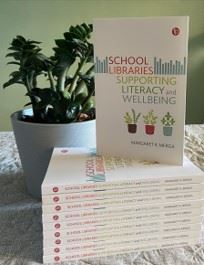
Title: School Libraries Supporting Literacy and Wellbeing
Author: Dr Margaret K. Merga
Reviewer: Vicki Bennett
The importance of school libraries and how they support student wellbeing and develop essential literacy skills is a relevant and complex topic that Margaret Merga explores comparing school libraries in the U.K., Australia, and USA. Her book also offers extensive evidence and data about how school libraries support student wellbeing and literacy skills.
As a teacher librarian in two small Primary Schools in NSW, I found this book thought-provoking, fascinating, relevant, factual, and an essential read for all teacher librarians AND school leaders. Merga understands teacher librarians, their struggles, goals, and hopes for the future, and articulates them perfectly.
The importance of how “Reading for Pleasure” (RfP) improves students’ educational outcomes is something all school leaders should be interested in. Student wellbeing has always been a concern in schools but has increased over the last two years of COVID. In each chapter, Merga provides evidence on how school libraries support student wellbeing and literacy development, and fuels ideas on how important it is to increase support of students and teacher librarians. There is so much room for further research and Merga provides many starting points for this.
Chapter 1: Explores the links and evidence between school libraries and students’ performance. Comparisons between school library systems in the UK and Australia are explored and prompt the question: What is the difference between a school librarian and a teacher librarian? The UK has school librarians (generally, without teaching degrees) and Australia has teacher librarians. The name itself is the ultimate clue. This chapter also breaks down each role and discusses “job creep.”
Chapter 2: Focuses on literacy and the ways in which school libraries can, and do, support a love of “Reading for Pleasure” (RfP) are integral to this chapter.
Chapter 3: Discusses how school/teacher librarians and school library professionals have an integral role in supporting “Struggling Literacy Learners” (SLL) beyond the early years. Merga also discusses how the term “struggle” should not be avoided to describe students, because if we don’t call it a struggle, we are diminishing their difficulties and their need for support. Who these struggling students are and how they can be supported by school libraries is also explored in this chapter.
Chapter 4: Reading engagement and reading for pleasure develop more than literacy; they contribute to social and emotional intelligence. Merga notes that the ability to lose oneself within a book is an escape for many, while relating to characters, reading about similar life situations, learning empathy, not feeling isolated by one’s beliefs, and finding a connection somewhere often creates a sense of belonging. Therefore, it is important to ensure the availability of diverse literature in school libraries.
Chapter 5: The provision of appropriate and factual texts and information to support students’ health, wellbeing and information literacy is explored in this chapter. Merga’s discussion also explores the importance of resourcing for caregivers. The importance of a qualified teacher librarian to teach students how to discern and identify information is also highlighted, as is the need for future research in this area.
Chapter 6: Explores the importance of the design, accessibility, and availability of library spaces for students’ wellbeing. As a student who used the school library as their safe haven and the space where I felt I belonged, this chapter reinforced for me the importance of school libraries and highlights how they support the wellbeing for many students with diverse needs.
Chapter 7: Why do we need qualified teacher librarians and school libraries? While I found all the chapters important and relevant, this chapter was my favourite. Teacher librarians need to advocate for their role, work within their role, maintain their libraries, and not burn out; this is a very real and difficult struggle. Merga poses the question: Why does the teacher librarian need to advocate for a role that is undoubtably essential for students’ literacy and wellbeing? The role is misunderstood by many and there is an obvious need for more research in this area. Merga also suggests that it stems from the deprofessionalisation of the role and the lack of clarity about what the role entails. The importance of a physical library space and physical books is also explored. The discussion about how well readers comprehend when reading from a screen in comparison to a physical book is also an area that is highlighted. Merga’s discussion about these topics is valid and important.
In conclusion, this book is an essential read for all educators as it highlights the importance of well-designed and well-resourced school libraries lead by qualified school/teacher librarians to support wellbeing and literacy for all students. It also highlights, however, the very real struggle of qualified teacher librarians and school libraries. When the evidence indicates that it is detrimental for our students to not have access to a qualified teacher librarian and a school library, the question is, why is it such a struggle? Merga highlights all these issues and offers ideas on how we can address this for the future.